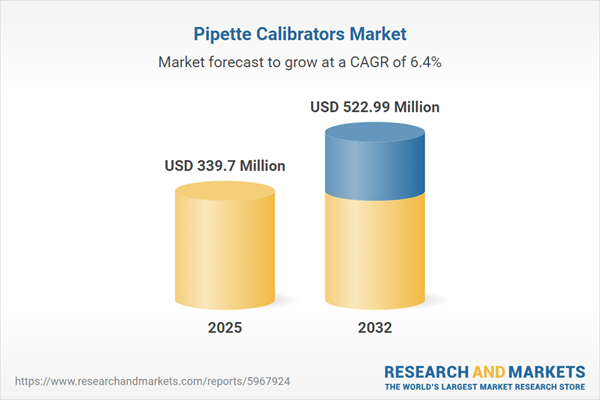Speak directly to the analyst to clarify any post sales queries you may have.
The pipette calibrators market is evolving with rapid advancements in digital calibration, reshaping laboratory practices for pharmaceutical, biotechnological, and research organizations worldwide. Decision-makers are prioritizing technology integration, regulatory compliance, and quality assurance to remain competitive in a dynamic environment driven by global demand for accurate liquid handling.
Market Snapshot: Global Pipette Calibrators Market Overview
The pipette calibrators market grew from USD 319.13 million in 2024 to USD 339.70 million in 2025, and is expected to continue expanding at a CAGR of 6.36%, reaching USD 522.99 million by 2032. Heightened requirements for precise measurement in laboratories are driving this growth, supported by continued investments in automation, regulatory compliance, and globalization of pharmaceutical and diagnostic sectors. Strategic moves by established technology vendors and emerging service providers continue to shape the competitive landscape.
Scope & Segmentation
This report delivers an in-depth analysis of the global pipette calibrators market, with an emphasis on evolving segments, regional trends, and technology adoption:
- Product Type: Digital pipette calibrators with software analytics, manual pipette calibrators for mechanical adjustments
- End User: Academic research and government laboratories, clinical diagnostics facilities, food and beverage testing centers, biotechnology firms, and pharmaceutical companies
- Pipette Type: Electronic pipettes, multi-channel pipettes, single-channel pipettes
- Calibration Location: Onsite and offsite calibration services
- Service Provider: In-house calibration teams and third-party service providers
- Regions: Americas (including North America and Latin America), Europe, Middle East & Africa, Asia-Pacific. Key countries include the United States, Canada, Brazil, Germany, China, Japan, India, and more
- Technological Focus: Cloud-based data platforms, software-driven calibration, wireless connectivity, integration with laboratory information management systems (LIMS), and eco-friendly protocols
- Leading Companies: Thermo Fisher Scientific Inc., Mettler-Toledo International Inc., Sartorius AG, Eppendorf SE, Gilson, BRAND GMBH + CO KG, Artel, Socorex Isba SA, Hamilton Company, Cole-Parmer Instrument Company LLC
Key Takeaways for Senior Decision-Makers
- Digital transformation is redefining industry standards as laboratories favor software-based pipette calibrators for increased accuracy, higher throughput, and traceability.
- Regulatory expectations are rising globally, impacting calibration protocols and documentation practices, especially in pharmaceutical and clinical settings.
- Supply chain volatility, including policy changes and tariff introductions, is prompting strategic realignment towards localized manufacturing, flexible sourcing, and bundled calibration services.
- Sustainability considerations are reshaping procurement, with demand growing for green calibration solutions that minimize waste, energy use, and operational disruptions.
- New service models, such as subscription-based offerings and co-developed hardware-software solutions, promote budget predictability and process efficiency for end users.
- Regional dynamics, like ramped-up R&D in North America, green initiatives in Europe, and healthcare expansion in Asia-Pacific, continue to diversify market expectations and adoption patterns.
Pipette Calibrators Market Tariff Impact
Recent United States tariffs on laboratory equipment and services are increasing component and product costs, especially for smaller laboratories with limited purchasing leverage. This is prompting organizations to revise sourcing strategies, emphasize domestic manufacturing, and seek suppliers from tariff-exempt regions. While localization helps counter increased expenses, it raises challenges in production capacity and lead times. Multinational players are pursuing consolidated contracts and optimized logistics to achieve cost efficiencies and sustain compliance.
Pipette Calibrators Market: Methodology & Data Sources
This research is built on primary interviews with calibration managers, regulatory experts, laboratory directors, and equipment manufacturers, complemented by surveys of laboratory end users across multiple sectors. Secondary sources include industry literature, regulatory documents, patents, and trade reports. Market triangulation and expert review panels ensure data relevance, consistency, and credibility.
Why This Report Matters
- Provides actionable intelligence to guide capital investment in digital calibration tools and sustainable solutions.
- Enables data-driven strategy for navigating evolving regulations and managing supply chain risk.
- Supports benchmarking of service models and technology adoption across regional and global operations.
Conclusion
Senior leaders equipped with timely data and actionable insights from this report can confidently shape pipette calibration initiatives, ensuring operational precision and alignment with both regional and global industry shifts.
Additional Product Information:
- Purchase of this report includes 1 year online access with quarterly updates.
- This report can be updated on request. Please contact our Customer Experience team using the Ask a Question widget on our website.
Table of Contents
3. Executive Summary
4. Market Overview
7. Cumulative Impact of Artificial Intelligence 2025
Companies Mentioned
The companies profiled in this Pipette Calibrators market report include:- Thermo Fisher Scientific Inc.
- Mettler-Toledo International Inc.
- Sartorius AG
- Eppendorf SE
- Gilson, Inc.
- BRAND GMBH + CO KG
- Artel, LLC
- Socorex Isba SA
- Hamilton Company
- Cole-Parmer Instrument Company LLC
Table Information
| Report Attribute | Details |
|---|---|
| No. of Pages | 185 |
| Published | October 2025 |
| Forecast Period | 2025 - 2032 |
| Estimated Market Value ( USD | $ 339.7 Million |
| Forecasted Market Value ( USD | $ 522.99 Million |
| Compound Annual Growth Rate | 6.3% |
| Regions Covered | Global |
| No. of Companies Mentioned | 11 |









